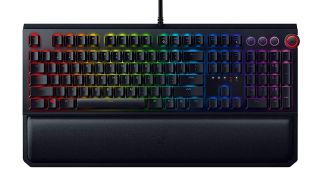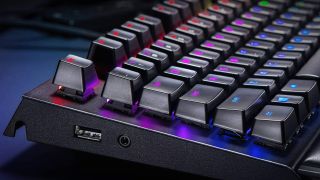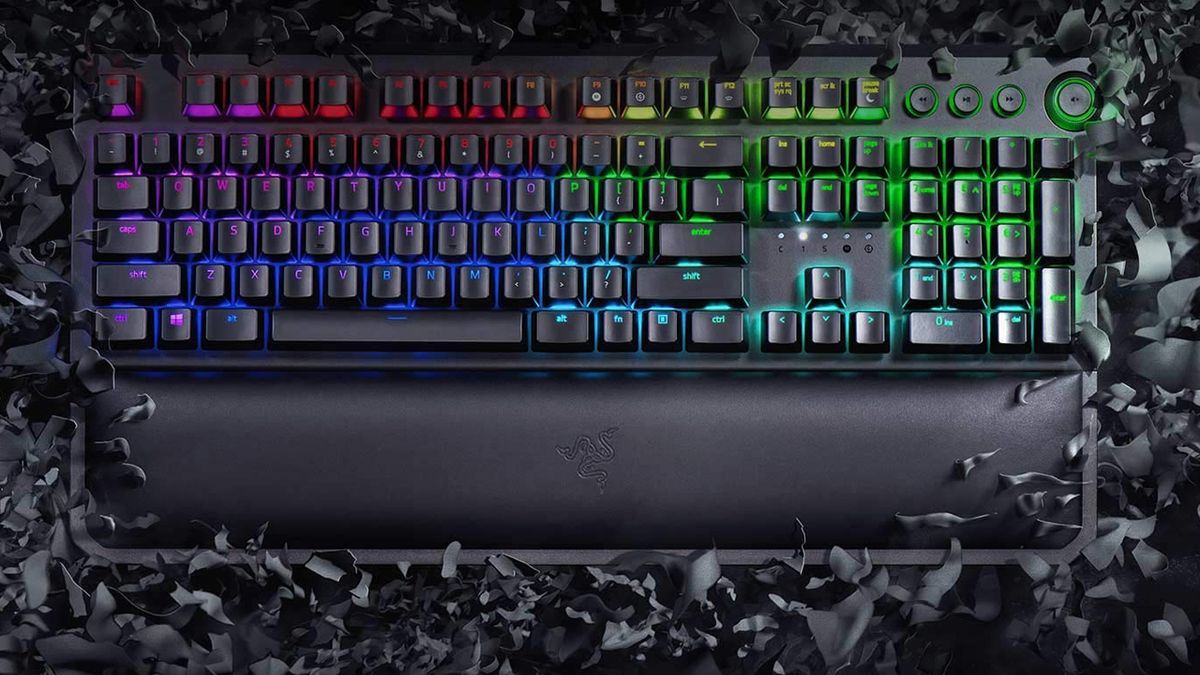12DOVE Verdict
A tactile, high-performance gaming keyboard with highly responsive switches. But you definitely pay for it, and while it's a nice piece of kit, it isn't the best out there.
Pros
- +
Quality construction
- +
Responsive switches
- +
Click! Click! Clicky-click!
Cons
- -
Not amazing for long periods of typing
- -
Dedicated macro keys are no more
- -
Pretty expensive
Why you can trust 12DOVE
Razer has been making Blackwidow mechanical gaming keyboards for many years, and each release sees tweaks to the design. They usually light up bright green, and are so clicky as to be unignorable. They also have a row of programmable macro keys on the left-hand side... except the Elite doesn’t. Has Razer learned restraint?
Of course not. It has RGB lighting and a new digital dial instead, plus with Hypershift any key can be a macro key. With the manufacturer’s usual hyperbole, this is a “tournament grade” plank that’s “designed as the most complete mechanical gaming keyboard in any arena”. To get this, however, you have to stump up £170/$170, slightly more than competitors from Corsair [K70 Lux] and Logitech [Orion Spark], which may persuade some that it’s not totally necessary to be the most complete in absolutely every arena. Pay the cost of entry, however, and you get a hugely robust and highly customizable keyboard, and one that excels for gaming. But is it enough to earn a spot on our best gaming keyboards list? Let's find out.
Razer Blackwidow Elite - Design

For a company that’s so keen on having color spilling out of its keyboards, Razer sure does like black. When switched off, the Elite gives no clue to the amount of light it’s capable of emitting.
It’s a tall keyboard, the underlying frame thick and the keys standing proud on their stalks. It’s also fairly heavy, with some nice thick rubber pads to prevent it sliding around on the desktop. It’s reassuring, although perhaps not luxurious, and the two feet that serve to adjust the board’s angle are well-thought out, with two levels of enhancement and a positive click when they snap into place. There’s a padded PVC wrist rest included in the box too, which cleverly attaches to the front of the board with magnets and is extremely comfortable to use, staying cool even under the hottest wrist-based onslaught.
The keys are concave and understated, with sharp edges that let you know immediately if your finger isn’t quite perched centrally. In the top right corner live the media keys, which don’t sit on mechanical switches, but still manage to make a loud click when pressed - not ideal if trying to discreetly pause something. The dial, which hangs over the right side of the board, clicks as it rotates but doesn’t have a start or stop point.
Razer Blackwidow Elite - Features

Two USB plugs and a 3.5mm audio jack trail from the nicely braided cable at the back end of the Elite. There’s a single USB 2 port and a headphone socket at the left of the keyboard frame, a convenient way of plugging in some cans or a USB headset without reaching down the back of your PC.
The lack of macro keys really doesn’t matter as, thanks to Razer’s Hypershift system, you can program any of the keyboard’s buttons to do whatever you want as a secondary function using a modifier key. The Razer Synapse software, which controls the RGB lighting as well as the programmability, is by now a mature product that works well, and shouldn’t give anybody any problems in use. Lighting schemes include breathing, rainbow waves, and a responsive option, that changes the color of keys as you hit them. There are also schemes tailored to specific games.
The dial at the top right mirrors that of the Huntsman Elite, and can be programmed to alter audio volume, or act as a jog-dial to change tracks, or many other things. It’s a nice addition, though not as versatile as the Logitech Craft keyboard’s dial.
Razer Blackwidow Elite - Performance

Razer uses its own switches in its keyboards these days, which means - of course - that if you pop a key off you’ll find a colored stalk underneath. Ours has the noisy, clicky green switches, but versions with quieter orange or smoother yellow switches are available. They’re all slightly different, but all well designed, with an enormous lifespan of 80 million keystrokes and protection against both liquid spills and dust encrustations.
The actuation point is very high, however. Having the keystroke registered following just a light tap of the key enables extra responsiveness, and even a slight mis-hit with a finger can still activate missiles or healing magic or whatever you’ve got bound to a key. Compare these green-cross nodes with something that uses Cherry MX switches, such as the HyperX Alloy Elite, and you’ll notice the difference. The Cherry switch allows you to rest your finger on a key with no danger of it going off accidentally. This is useful if you’re sneaking up behind someone in a game such as Hitman 2 or Assassin’s Creed Odyssey - catching someone unawares with a length of sharp metal is a game of perfect timing.
The hair-trigger switches and lofty key height also make it a tiring keyboard to type on for any length of time. The noise, though thrilling in a moment of adrenaline-soaked glory, can also begin to grate.
Overall - Should you buy it?
Blackwidow keyboards have been at the top of the mechanical tree for many years, and this latest Elite iteration seems likely to keep it there. The removal of the macro keys may upset some, particularly those who have used previous Blackwidows for a while and are used to their way of doing things. There’s no denying the quality of the materials or the construction, and the green switches will delight gamers who prize responsiveness and speed, as well as a clicking that can be driven to chainsaw-like levels of buzz when you’re moving really fast. The Elite may look understated, but becomes ostentatious when its lighting is fully powered up, and that’s just the way we like it.
Ian Evenden is an experienced freelance writer whose words can be found everywhere from GamesRadar and PC Gamer to T3 and Tom's Hardware. Ian spent years as the Production Editor for Edge magazine, and has gone on to contribute to a wide variety of gaming, computing, science, and technology publications for well over a decade. Legend has it that Ian disapproves of Oxford commas… sorry Ian, but there's no stopping us now.

A new Batman #1 from Matt Fraction and Jorge Jiménez launches this September with a "revamped aesthetic," a throwback costume, and a new Batmobile

Marvel reveals its full slate of May 2025 comics and covers featuring the Avengers, the X-Men, Spider-Man, and more

Former Witcher 3 lead says his new vampire RPG Blood of Dawnwalker has a smaller open world because "it feels more like you actually know the place" compared to "behemoths"
Most Popular




